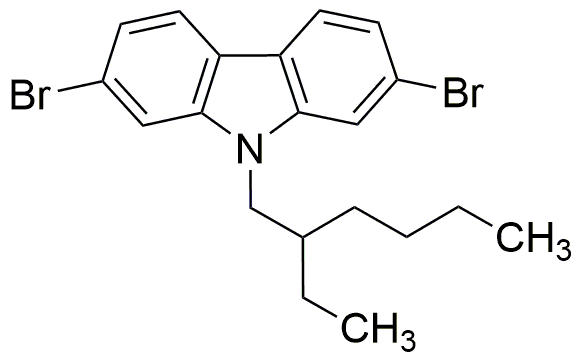2,7-Dibromo-9-(2-ethylhexyl)carbazole is widely utilized in research focused on:
- Organic Photovoltaics: This compound is used as a material in organic solar cells, enhancing their efficiency and stability. Its unique structure allows for better light absorption and charge transport.
- Light-Emitting Diodes (LEDs): It serves as a key component in the development of high-performance LEDs, contributing to improved brightness and energy efficiency in various lighting applications.
- Fluorescent Sensors: The compound is employed in creating fluorescent sensors for detecting environmental pollutants, providing a sensitive and reliable method for monitoring air and water quality.
- Polymer Additives: Used as an additive in polymer formulations, it enhances thermal stability and mechanical properties, making it valuable in the production of durable materials for automotive and construction industries.
- Research in Photonic Devices: It is explored in the development of advanced photonic devices, offering potential applications in telecommunications and data processing due to its favorable optical properties.
General Information
Properties
Safety and Regulations
Applications
2,7-Dibromo-9-(2-ethylhexyl)carbazole is widely utilized in research focused on:
- Organic Photovoltaics: This compound is used as a material in organic solar cells, enhancing their efficiency and stability. Its unique structure allows for better light absorption and charge transport.
- Light-Emitting Diodes (LEDs): It serves as a key component in the development of high-performance LEDs, contributing to improved brightness and energy efficiency in various lighting applications.
- Fluorescent Sensors: The compound is employed in creating fluorescent sensors for detecting environmental pollutants, providing a sensitive and reliable method for monitoring air and water quality.
- Polymer Additives: Used as an additive in polymer formulations, it enhances thermal stability and mechanical properties, making it valuable in the production of durable materials for automotive and construction industries.
- Research in Photonic Devices: It is explored in the development of advanced photonic devices, offering potential applications in telecommunications and data processing due to its favorable optical properties.
Documents
Safety Data Sheets (SDS)
The SDS provides comprehensive safety information on handling, storage, and disposal of the product.
Product Specification (PS)
The PS provides a comprehensive breakdown of the product’s properties, including chemical composition, physical state, purity, and storage requirements. It also details acceptable quality ranges and the product's intended applications.
Certificates of Analysis (COA)
Search for Certificates of Analysis (COA) by entering the products Lot Number. Lot and Batch Numbers can be found on a product’s label following the words ‘Lot’ or ‘Batch’.
*Catalog Number
*Lot Number
Certificates Of Origin (COO)
This COO confirms the country where the product was manufactured, and also details the materials and components used in it and whether it is derived from natural, synthetic, or other specific sources. This certificate may be required for customs, trade, and regulatory compliance.
*Catalog Number
*Lot Number
Safety Data Sheets (SDS)
The SDS provides comprehensive safety information on handling, storage, and disposal of the product.
DownloadProduct Specification (PS)
The PS provides a comprehensive breakdown of the product’s properties, including chemical composition, physical state, purity, and storage requirements. It also details acceptable quality ranges and the product's intended applications.
DownloadCertificates of Analysis (COA)
Search for Certificates of Analysis (COA) by entering the products Lot Number. Lot and Batch Numbers can be found on a product’s label following the words ‘Lot’ or ‘Batch’.
*Catalog Number
*Lot Number
Certificates Of Origin (COO)
This COO confirms the country where the product was manufactured, and also details the materials and components used in it and whether it is derived from natural, synthetic, or other specific sources. This certificate may be required for customs, trade, and regulatory compliance.


